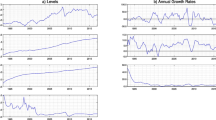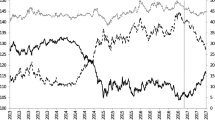Abstract
A factor structure for VAR model error terms is adopted to examine the dynamic relationships of major macroeconomic time series. The structure, which is testable, is used to trace the consequences of a contemporaneously “ceteris paribus” (or idiosyncratic) change in each variable in the VAR model. The impulse responses to idiosyncratic shocks are shown to be a dynamic representation of the Granger causality. In the analyses of the US monthly data from 1954 to 2011 for four key variables, inflation is found to respond negatively (positively) to an increase in unemployment (the federal funds rate), holding other variables contemporaneously fixed. The real variables (output and unemployment) appear unresponsive to idiosyncratic changes in the nominal variables (the federal funds rate and inflation). A common factor is observed to have a positive effect on unemployment and negative effects on output, inflation and the federal funds rate.



Similar content being viewed by others
Notes
Rudebusch (1998) argues that the FFR equation in a VAR does not approximate the US Federal Reserves’ reaction function well because the information available to econometricians is different from that available to the US Federal Reserve and the reaction function itself changes over time. Sims (1992) also points out that the results from a VAR may not be reliable if the monetary policy authorities have better information about future inflation than that obtainable from the variables in the VAR.
The estimation of the standard errors is difficult when the impulse responses are close to zero. Under such circumstances, the delta method and usual bootstrap techniques may produce unreliable estimates (see Benkwitz et al. 2000).
References
Altonji J, Ham J (1990) Employment variations in Canada: the role of external, regional, and industrial factors. J Labor Econ 8(1 part 2):S198–S236
Anderson TW, Rubin H (1956) Statistical inference in factor analysis. In: Neyman J (ed) Proceedings of the third Berkeley symposium on mathematical statistics and probability, vol 5. University of California Press, Berkeley, pp 111–150
Benkwitz A, Lütkepohl H, Newmann MH (2000) Problems related to confidence intervals for impulse responses of autoregressive processes. Econ Rev 19:p69–103
Bernanke BS, Blinder AS (1992) The federal funds rate and the channels of monetary transmission. Am Econ Rev 82(4):901–921
Bernanke BS, Boivin J, Eliasz P (2005) Measuring the effects of monetary policy: a factor-augmented vector autoregressive (FAVAR) approach. Q J Econ 120:387–422
Blanchard O, Quah D (1989) The dynamic effects of aggregate demand and supply disturbances. Am Econ Rev 79:655–673
Christiano LJ, Eichenbaum M, Evans CL (1996) The effects of monetary policy shocks: evidence from the flow of funds’. Rev Econ Stat 78(1):16–34
Christiano LJ, Eichenbaum M, Evans CL (1999) Monetary policy shocks: what have we learned and to what end? In: Taylor J, Woodford M (eds) Handbook of macroeconomics, vol 1., Part AElsevier Science, Amsterdam, pp 65–148
Fraust J, Leeper EM (1997) When do long-run identifying restrictions give reliable results? J Bus Econ Stat 15(3):345–353
Giannone D, Reichlin L, Sala L (2006) VARs, common factors and the empirical validation of equilibrium business cycle models. J Econ 132(1):257–279
Gourieroux C, Monfort A (1989) Statistics and econometric models 1 and 2 (trans: Vuong Q). University Press, Cambridge
Kilian L (2013) Structural vector autoregressions. In: Hashimzade N, Thornton M (eds) Handbook of research methods and applications in empirical macroeconomics. Edward Elgar Publishing, Cheltenham, pp 515–554
Leeper EM, Sims CA (1996) Zha T (1996) What does monetary policy do? Brook Pap Econ Act 2:1–63
Ng S, Stevanovi D (2012) Factor augmented autoregressive distributed lag models. working paper. http://www.columbia.edu/~sn2294/papers/fadl.pdf
Norrbin SC, Schlagenhauf DE (1996) The role of international factors in the business cycle: a multi-country study. J Int Econ 40:85–104
Rudebusch GD (1998) Do measures of monetary policy in a VAR make sense. Int Econ Rev 39(4):907–931
Sims CA (1980) Macroeconomics and reality. Econometrica 48:1–48
Sims CA (1992) Interpreting the macroeconomic time series facts. Eur Econ Rev 36:975–1011
Sims CA, Zha T (2006) Does monetary policy generate recessions? Macroecon Dyn 10(02):231–272
Stock JH, Watson MW (2001) Vector autoregressions. J Econ Perspect 15(4):101–115
Stock JH, Watson MW (2005) Understanding changes in international business cycle dynamics. J Eur Econ Assoc 3(5):968–1006
Stock JH, Watson MW (2011) Dynamic factor models. In: Clements MP, Hendry DF (eds) Oxford handbook of economic forecasting. Oxford University Press, Oxford
Uhlig H (2005) What are the effects of monetary policy on output? J Monet Econ 52:381–419
Author information
Authors and Affiliations
Corresponding author
Additional information
This paper benefited from conversations with Lance Fisher, Glenn Otto and Adrian Pagan. I thank Robert Kunst (Editor) and two anonymous referees for their comments that led to many improvements to the paper. I am responsible for all remaining errors.
Rights and permissions
About this article
Cite this article
Yang, M. Effects of idiosyncratic shocks on macroeconomic time series. Empir Econ 53, 1441–1461 (2017). https://doi.org/10.1007/s00181-016-1184-3
Received:
Accepted:
Published:
Issue Date:
DOI: https://doi.org/10.1007/s00181-016-1184-3
Keywords
- Vector autoregression
- Error factor
- Identification
- Granger causality
- Impulse responses
- Phillips curve
- Monetary neutrality




